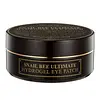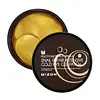What's inside
What's inside
 Key Ingredients
Key Ingredients

 Benefits
Benefits

 Concerns
Concerns

 Ingredients Side-by-side
Ingredients Side-by-side

Water
Skin ConditioningGlycerin
HumectantDipropylene Glycol
HumectantNiacinamide
SmoothingCarrageenan
Saccharomyces/Snail Secretion Filtrate Ferment Filtrate
Skin ConditioningButylene Glycol
HumectantCharcoal Powder
AbrasiveGlucose
HumectantPotassium Chloride
Hydroxyethylcellulose
Emulsion StabilisingDiamond Powder
AbrasivePropanediol
SolventSodium Hyaluronate
HumectantPearl Powder
Citrus Unshiu Peel Extract
MaskingP-Anisic Acid
MaskingBeta-Glucan
Skin ConditioningGold
Cosmetic ColorantLevulinic Acid
PerfumingMelaleuca Alternifolia Leaf Water
AntimicrobialEucalyptus Globulus Leaf Extract
PerfumingAlthaea Rosea Flower Extract
Skin ConditioningAloe Barbadensis Leaf Extract
EmollientPunica Granatum Fruit Extract
AntioxidantPorphyra Yezoensis Extract
Skin ConditioningChlorella Vulgaris Extract
Skin ConditioningLaminaria Japonica Extract
Skin ProtectingChamomilla Recutita Flower Extract
MaskingGlycine Soja Phytoplacenta Extract
Skin ConditioningCamellia Sinensis Leaf Extract
AntimicrobialCopper Tripeptide-1
Skin ConditioningDextrin
AbsorbentCeratonia Siliqua Gum
EmollientCyamopsis Tetragonoloba Gum
Emulsion StabilisingMica
Cosmetic ColorantTitanium Dioxide
Cosmetic ColorantIron Oxides
Panthenol
Skin ConditioningArginine
MaskingBee Venom
AstringentEthylhexylglycerin
Skin ConditioningAdenosine
Skin Conditioning1,2-Hexanediol
Skin ConditioningAniba Rosodora Wood Oil
AstringentWater, Glycerin, Dipropylene Glycol, Niacinamide, Carrageenan, Saccharomyces/Snail Secretion Filtrate Ferment Filtrate, Butylene Glycol, Charcoal Powder, Glucose, Potassium Chloride, Hydroxyethylcellulose, Diamond Powder, Propanediol, Sodium Hyaluronate, Pearl Powder, Citrus Unshiu Peel Extract, P-Anisic Acid, Beta-Glucan, Gold, Levulinic Acid, Melaleuca Alternifolia Leaf Water, Eucalyptus Globulus Leaf Extract, Althaea Rosea Flower Extract, Aloe Barbadensis Leaf Extract, Punica Granatum Fruit Extract, Porphyra Yezoensis Extract, Chlorella Vulgaris Extract, Laminaria Japonica Extract, Chamomilla Recutita Flower Extract, Glycine Soja Phytoplacenta Extract, Camellia Sinensis Leaf Extract, Copper Tripeptide-1, Dextrin, Ceratonia Siliqua Gum, Cyamopsis Tetragonoloba Gum, Mica, Titanium Dioxide, Iron Oxides, Panthenol, Arginine, Bee Venom, Ethylhexylglycerin, Adenosine, 1,2-Hexanediol, Aniba Rosodora Wood Oil
Water
Skin ConditioningGlycerin
HumectantCalcium Chloride
AstringentCeratonia Siliqua Gum
EmollientXanthan Gum
EmulsifyingNiacinamide
SmoothingDipropylene Glycol
HumectantMethylpropanediol
SolventSnail Secretion Filtrate
Skin Conditioning1,2-Hexanediol
Skin ConditioningPentylene Glycol
Skin ConditioningCitrus Grandis Seed Extract
AstringentBambusa Textilis Stem Extract
Skin ConditioningPinus Palustris Leaf Extract
TonicChondrus Crispus Powder
AbrasiveHydrolyzed Collagen
EmollientPEG-60 Hydrogenated Castor Oil
EmulsifyingEthylhexylglycerin
Skin ConditioningPhellinus Linteus Extract
Skin ConditioningInonotus Obliquus Extract
Skin ConditioningGold
Cosmetic ColorantAdenosine
Skin ConditioningOctapeptide-7
Skin ProtectingSh-Octapeptide-4
AntioxidantSh-Oligopeptide-4
Skin ConditioningSh-Decapeptide-7
AntioxidantSh-Decapeptide-9
Skin ConditioningSh-Pentapeptide-19
Skin ConditioningCaffeoyl Tripeptide-1
AntioxidantHydroxyethylcellulose
Emulsion StabilisingSynthetic Fluorphlogopite
Tin Oxide
AbrasiveTitanium Dioxide
Cosmetic ColorantCI 77491
Cosmetic ColorantPhenoxyethanol
PreservativeDisodium EDTA
Parfum
MaskingWater, Glycerin, Calcium Chloride, Ceratonia Siliqua Gum, Xanthan Gum, Niacinamide, Dipropylene Glycol, Methylpropanediol, Snail Secretion Filtrate, 1,2-Hexanediol, Pentylene Glycol, Citrus Grandis Seed Extract, Bambusa Textilis Stem Extract, Pinus Palustris Leaf Extract, Chondrus Crispus Powder, Hydrolyzed Collagen, PEG-60 Hydrogenated Castor Oil, Ethylhexylglycerin, Phellinus Linteus Extract, Inonotus Obliquus Extract, Gold, Adenosine, Octapeptide-7, Sh-Octapeptide-4, Sh-Oligopeptide-4, Sh-Decapeptide-7, Sh-Decapeptide-9, Sh-Pentapeptide-19, Caffeoyl Tripeptide-1, Hydroxyethylcellulose, Synthetic Fluorphlogopite, Tin Oxide, Titanium Dioxide, CI 77491, Phenoxyethanol, Disodium EDTA, Parfum
 Reviews
Reviews

Ingredients Explained
These ingredients are found in both products.
Ingredients higher up in an ingredient list are typically present in a larger amount.
1,2-Hexanediol is a synthetic liquid and another multi-functional powerhouse.
It is a:
- Humectant, drawing moisture into the skin
- Emollient, helping to soften skin
- Solvent, dispersing and stabilizing formulas
- Preservative booster, enhancing the antimicrobial activity of other preservatives
Adenosine is in every living organism. It is one of four components in nucleic acids that helps store our DNA.
Adenosine has many benefits when used. These benefits include hydrating the skin, smoothing skin, and reducing wrinkles. Once applied, adenosine increases collagen production. It also helps with improving firmness and tissue repair.
Studies have found adenosine may also help with wound healing.
In skincare products, Adenosine is usually derived from yeast.
Learn more about AdenosineCeratonia Siliqua Gum is extracted from the seeds of the carob tree. You might know this ingredient as Carob Gum or Locust Bean Gum. It is used to stabilize other ingredients and improve the texture of products.
Carob gum is made up of long-chain polysaccharides. This makes it a natural thickener.
Yes! This ingredient comes from the seeds of a tree. The name 'Locust Bean Gum' can be misleading.
Learn more about Ceratonia Siliqua GumDipropylene Glycol is a synthetically created humectant, stabilizer, and solvent.
This ingredient helps:
Dipropylene glycol is technically an alcohol, but it belongs to the glycol family (often considered part of the ‘good’ alcohols). This means it is hydrating and gentle on skin unlike drying solvent alcohols like denatured alcohol.
As a masking agent, Dipropylene Glycol can be used to cover the smell of other ingredients. However, it does not have a scent.
Studies show Dipropylene Glycol is considered safe to use in skincare.
Learn more about Dipropylene GlycolEthylhexylglycerin (we can't pronounce this either) is commonly used as a preservative and skin softener. It is derived from glyceryl.
You might see Ethylhexylglycerin often paired with other preservatives such as phenoxyethanol. Ethylhexylglycerin has been found to increase the effectiveness of these other preservatives.
Glycerin is already naturally found in your skin. It helps moisturize and protect your skin.
A study from 2016 found glycerin to be more effective as a humectant than AHAs and hyaluronic acid.
As a humectant, it helps the skin stay hydrated by pulling moisture to your skin. The low molecular weight of glycerin allows it to pull moisture into the deeper layers of your skin.
Hydrated skin improves your skin barrier; Your skin barrier helps protect against irritants and bacteria.
Glycerin has also been found to have antimicrobial and antiviral properties. Due to these properties, glycerin is often used in wound and burn treatments.
In cosmetics, glycerin is usually derived from plants such as soybean or palm. However, it can also be sourced from animals, such as tallow or animal fat.
This ingredient is organic, colorless, odorless, and non-toxic.
Glycerin is the name for this ingredient in American English. British English uses Glycerol/Glycerine.
Learn more about GlycerinWe don't have a description for Gold yet.
Hydroxyethylcellulose is used to improve the texture of products. It is created from a chemical reaction involving ethylene oxide and alkali-cellulose. Cellulose is a sugar found in plant cell walls and help give plants structure.
This ingredient helps stabilize products by preventing ingredients from separating. It can also help thicken the texture of a product.
This ingredient can also be found in pill medicines to help our bodies digest other ingredients.
Learn more about HydroxyethylcelluloseNiacinamide is a multitasking form of vitamin B3 that strengthens the skin barrier, reduces pores and dark spots, regulates oil, and improves signs of aging.
And the best part? It's gentle and well-tolerated by most skin types, including sensitive and reactive skin.
You might have heard of "niacin flush", or the reddening of skin that causes itchiness. Niacinamide has not been found to cause this.
In very rare cases, some individuals may not be able to tolerate niacinamide at all or experience an allergic reaction to it.
If you are experiencing flaking, irritation, and dryness with this ingredient, be sure to double check all your products as this ingredient can be found in all categories of skincare.
When incorporating niacinamide into your routine, look out for concentration amounts. Typically, 5% niacinamide provides benefits such as fading dark spots. However, if you have sensitive skin, it is better to begin with a smaller concentration.
When you apply niacinamide to your skin, your body converts it into nicotinamide adenine dinucleotide (NAD). NAD is an essential coenzyme that is already found in your cells as "fuel" and powers countless biological processes.
In your skin, NAD helps repair cell damage, produce new healthy cells, support collagen production, strengthen the skin barrier, and fight environmental stressors (like UV and pollution).
Our natural NAD levels start to decline with age, leading to slower skin repair, visible aging, and a weaker skin barrier. By providing your skin niacinamide, you're recharging your skin's NAD levels. This leads to stronger, healthier, and younger looking skin.
Another name for vitamin B3 is nicotinamide. This vitamin is water-soluble and our bodies don't store it. We obtain Vitamin B3 from either food or skincare. Meat, fish, wheat, yeast, and leafy greens contain vitamin B3.
The type of niacinamide used in skincare is synthetically created.
Learn more about NiacinamideTitanium dioxide is a mineral UV filter widely used in sunscreens and cosmetics.
It is one of only two UV filters officially classified as “mineral” by regulatory agencies, the other being zinc oxide.
Titanium dioxide provides broad-spectrum protection mostly in the UVB and UVAII range, with some protection in the UVAI range.
While its UVA protection isn’t as strong as zinc oxide’s, the difference is minor.
A common myth is that mineral UV filters reflect UV light. However, modern research shows titanium dioxide absorbs UV radiation like chemical filters (~95% absorption & 5% reflection).
Thanks to its non-irritating nature, titanium dioxide is suitable for sensitive, acne-prone, or redness-prone skin. It is unlikely to cause "eye sting" like other sunscreen ingredients.
A major drawback of this ingredient is its white cast and thick texture. This is why mineral sunscreens often leave a white cast and are less cosmetically elegant than chemical/hybrid sunscreens.
To improve white cast and spreadability, micronized or nano-sized titanium dioxide is often used.
There are ongoing concerns surrounding nano-titanium oxide's impact on marine ecosystems.
There is no conclusive evidence that any form of titanium oxide (or any other sunscreen ingredients) will cause harm to marine ecosystems or coral reefs. The science is still developing but many consumers are keeping a close eye on this issue.
Please note, many destinations have reef-safety sunscreen rules. For instance, the U.S. Virgin Islands advises all visitors to use non-nano mineral sunscreens.
Nano mineral sunscreens once raised safety concerns about absorption into skin.
Extensive research has shown that they do not penetrate healthy or damaged skin; they remain safely on the surface and the top layer of dead skin (stratum corneum).
You'll likely find titanium dioxide bundled with alumina, silica, or dimethicone. These ingredients help make titanium dioxide highly photostable; this prevents it from interacting with other formula components under UV light.
Learn more about Titanium DioxideWater. It's the most common cosmetic ingredient of all. You'll usually see it at the top of ingredient lists, meaning that it makes up the largest part of the product.
So why is it so popular? Water most often acts as a solvent - this means that it helps dissolve other ingredients into the formulation.
You'll also recognize water as that liquid we all need to stay alive. If you see this, drink a glass of water. Stay hydrated!
Learn more about Water